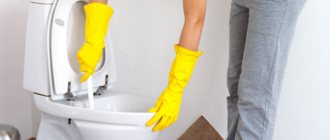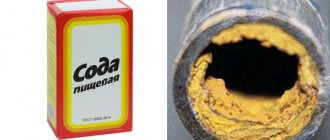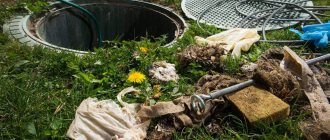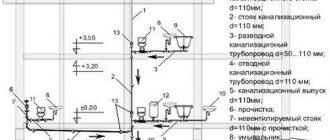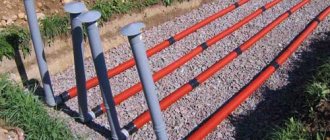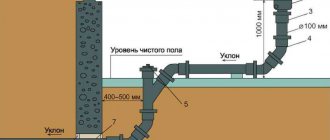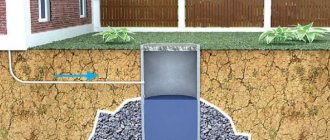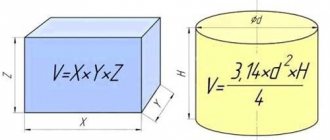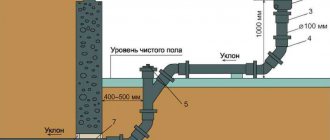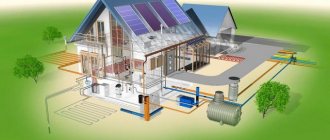Recommended articles:
Types of septic tanks for TOPAS dachas in combination with other systems What to choose TOPAS or UNILOS ASTRA? TOPAS septic tank with high groundwater Where to install a TOPAS septic tank on the site? DIY TOPAS maintenance
When installing a septic tank such as topas (based on the aeration principle), the question often arises: what can be poured into the septic tank, what is not desirable and what is strictly prohibited?
Aeration units operate on the principle of saturating water with air. Air bubbles do not allow the drain to settle, constantly mixing it due to aeration. Oxygen-saturated drainage allows for rapid growth of aerobic bacteria or otherwise activated sludge. Bacteria decompose and process the waste water entering the septic tank. As a result, at the outlet of the septic tank, clarified (purified) water with the smallest particles is obtained, suitable for watering trees or lawns and has no odor.
It is strictly forbidden to drain the following into a septic tank:
- Chlorine-containing detergents, such as Domestos, whiteness, toilet duck, etc.
- Alkalis and alkalis containing substances (mole, tyret, shumanite, laundry soap)
- Harsh disinfecting chemicals, antibiotics and drugs
- Mushrooms and mushroom waste - cleaning from them and even water are dangerous - a huge number of spores entering the septic tank begin the rapid development of mucus, which clogs the tubes and covers all surfaces with a layer.
- Discharge from filters for water purification (containing manganese, potassium salts, etc.)
All this, at a minimum, can lead to a malfunction of the station and the appearance of an odor, and, at maximum, to the need to pump out and restart the equipment. In these cases, it is recommended to drain these components bypassing the septic tank.
What can and cannot be poured into a Topas septic tank
Recently, local treatment facilities have become widespread. They can work very effectively for many years if a few simple rules are followed. It is worth paying close attention to the composition of wastewater, since it greatly affects the service life of the sewer system. If the wastewater contains substances that are unacceptable for discharge, foaming of the contents of the aeration tanks may occur and, as a result, the death of bacteria that process solid inclusions of liquid waste. As a result, it will be necessary to “reanimate” the VOC microflora using purchased bacterial preparations, and during the period of time required for its restoration, the septic tank will be inoperable.
It is worth considering in more detail what cannot be poured into a TOPAS septic tank. This list is quite extensive and includes a wide variety of waste from human and animal activities. It is strictly not recommended to pour out and throw away:
- remains of vegetables and fruits, especially rotten ones;
- waste from construction (gypsum, lime, sand);
- plastic bags, bottles, packaging;
- any medicines and medical products;
- water and liquids in which potassium permanganate is dissolved, oxidizing agents;
- bleaching agents;
- priming;
- pet hair;
- water after washing the mushrooms;
- machine and vegetable oils;
- gasoline, acid, brake fluid.
Throwing cigarettes and their filters, bandages and cotton wool, adhesive plaster and rags, contraceptives and personal hygiene products into the toilet can lead to blockages.
Unlike a conventional sewer system, you cannot pour the remains of soups and tea into the TOPAS septic tank, since bacteria will not be able to process them.
Proper operation of the septic tank guarantees its long service life. It is worth remembering: what is permissible for ordinary plumbing is not always permissible for a septic tank. For example, you should not use antiseptic or cleaning toilet nozzles.
Many people ask whether it is possible to throw toilet paper into a septic tank. Of course, it’s possible even with a bushing. The fact is that modern brands (Aqua Soft, Kleenex, Zewa, Papia) are able to completely dissolve without harming the bacteria and microorganisms of the septic tank.
Very often questions arise regarding the discharge of wastewater into the TOPAS septic tank with household chemicals dissolved in it, which are often used for laundry and dishwashing. It is worth clarifying that its chemical concentration in water is permissible only if it is used for domestic purposes. In the same way, you can pour out water after washing floors or wet cleaning in which detergent has been dissolved. However, experts still do not recommend oversaturating water with household chemicals!
Is it possible to drain water from a washing machine into TOPAS? The answer is definitely yes. The fact is that the air with which the pipes are blown can neutralize the effect of chemicals. And chlorine in washing powders, bleaches and detergents is replaced by less dangerous malic acid. If household chemicals are used when washing dishes in a cafe or restaurant, then a septic tank alone will not cope with it.
Fat
When you fry something meaty, your pan creates a thick layer of fat and oil. Pouring it down the sink is a bad idea. It will harden easily inside the pipes. Other foods also easily stick to fat. For example, the same rice or pasta. The grease itself, settling on the pipes, causes an unpleasant odor that can spread throughout the kitchen. It is better to pour the fat into a disposable container and throw it in the trash. It can also be used for re-frying. This will help you save vegetable oil.
Any medications, including expired ones
No, unnecessary tablets, old syrups and instant powders will not clog your drain. But through sewers they easily enter natural water bodies, polluting them. Modern wastewater treatment plants do not have equipment designed to filter drugs. Therefore, the chemicals they contain first end up in rivers, causing damage to the aquatic environment. And sometimes they end up back in drinking water.
If you want to get rid of the pills, it is better to throw them in the trash. Or at least mix them with vinegar and salt before disposing of them. This will help reduce their harmful effects. If the medicine has not yet expired, you can try to give it to people in need. Or try to find a company engaged in professional disposal of medical drugs.
Herring in spices: a recipe for those who like it spicy
Helmets for the police: strange measures to combat Covid in different countries
If I make dumplings for a holiday, then only in the form of a shell with a “pearl” inside
It is strictly forbidden to flush the following into the sewer:
- Contraception and hygiene products, cigarettes, plastic bags,
- Paints, solvents, petroleum products, machine oils, acids and alkalis,
- Chlorine-containing substances and drugs,
- Hair and fur from pets,
- Sand, lime, brick fragments and other construction waste.
These are the main substances and objects due to which an autonomous sewage system can become unusable. And to repair a septic tank, by the way, will cost you from 20-30 thousand rubles, and the smells from a faulty sewer system are not the most pleasant.
Dye
Any paint should not be poured down the drain. Artistic or painting - they are equally harmful to both your pipes and the environment. Firstly, the paint will fill the entire inner surface of the sewer, and then thicken and harden. Any blockage that appears will have to be broken through with a special solvent or removed manually.
Secondly, both art and paint paint contain many chemicals that are hazardous to the environment. Sewage treatment plants do not remove them from sewer water, so they end up in water and soil, contaminating them.
It is better to throw a small amount of paint in the trash. Let it harden first to prevent it from spilling. If you have a lot of paint left, you can donate it to needy families, schools or orphanages.
Bathroom and toilet room
What is prohibited from being thrown into the toilet and sink:
- Toilet paper. If the sewer system is designed as a septic tank, the paper will cause a blockage. You can flush it into the central sewer.
- Dental floss. Synthetic fibers accumulate in the system and form a dense jam. In addition, they do not dissolve in water and cause severe harm to the environment.
- Gum. Chewing gum does not dissolve in water, settles on the walls of the pipes and forms a blockage.
- Fishes. Dead aquarium fish clog drains and become a source of unpleasant odors. Canadian authorities are fining those who flush live fish down the toilet, which disrupt the country's natural ecosystem by ending up in ponds and lakes.
- Pepper patch and adhesive plaster. This is a mixture of fats, wax, resins, rubber, which does not dissolve in water and causes severe blockage.
- Contact lenses. One or even several pairs of lenses will not clog the toilet or sink drains, but once they get into the sewer, they will lie there for many years.
- Contents of a cat's litter box. Cat feces harden in the water and cause a clog. In addition, their toilet litter does not dissolve in water. Dispose of them along with other solid waste.
- Face masks. Cleansing masks based on clay and oils will accumulate in the sewer and clog the pipes. Remove the top layer of the mask with a damp cloth, and the remaining small particles are completely safe for pipes.
- Wet toilet paper, sanitary napkins. Even if such hygiene items are marked that they are water-soluble, there is no need to take risks and send them freely floating down the drain - the napkin dissolves in water after 3-4 hours, during which time a blockage easily forms.
- Tea brewing. Tea leaves accidentally flushed down the toilet once or twice will not cause much harm, but systematic draining of tea leaves will lead to an impenetrable compacted clog and the need to call a plumber to your home. The same goes for drinking a lot of coffee.
- Plastic bags. Not only do such things clog pipes, they pollute the environment, upsetting the natural balance.
- Medicines. Tablets and capsules dissolve in water, but cause irreparable harm to the environment - high concentrations of various chemicals in water poison it, because Even industrial filters are unable to completely purify water from such impurities.
- Construction garbage. Sand and small pebbles not only settle at the bottom of the pipes, clogging them, but at some point the pipes cannot withstand their weight and a burst occurs.
- Contraceptives. Condoms are made from latex, which does not dissolve. They stretch, cling to the walls of the pipes, fill with air and debris, creating a problem that is quite difficult to get rid of.
- Cigarette butts. The filter of most cigarettes consists of synthetics that swell in water, and poisonous substances - tar and nicotine - contaminate drinking water. In addition, after throwing away cigarette butts, a nauseating smell will linger in the house for a long time.
- Feminine hygiene products. Pads and tampons absorb a lot of water, causing clogs.
Eggshell
Eggshells do not decompose when exposed to hot water. Like rice, it also easily gathers into hard lumps, which are very difficult to soak and dissolve. Even though the shell may seem fragile at first glance, it can damage the inner surface of the pipes. Once gathered into a ball, the shells can easily cause severe blockage, which will have to be cleared mechanically.
Screens will have the ability to self-heal through oil
New Year's luck: Briton wins £39 million lottery
Kostomarov’s daughter turned 10 years old. The girl grew up to be a copy of her dad
How to properly dispose of it? Crush the eggshells and then throw them in the trash.
What is storm drainage
Storm drainage (technical designation K2, in everyday life simply storm drainage) is a system for receiving and transporting rainwater to the discharge point. Precipitation flows from the roof of buildings or from the surface of the earth into special receivers. Through them, water moves to the collector, enters the treatment plant (WTP), and then is discharged into the reservoir. To the question - is it necessary to have a storm sewer - there is always an affirmative answer. The presence of a properly equipped storm drain is a mandatory requirement for the improvement of a populated area. Rainwater collection must be properly organized, as required by current legislation. Tasks of K2 systems:
- removal of excess rain and melt water;
- protection of foundations and other supporting structures of buildings and structures;
- exclusion of flooding of basements, tunnels, subways and other objects.
Discharge of storm sewerage into a water body (drinking reservoir) without treatment is prohibited. However, extreme discharges are allowed when the volume of wastewater is greatly exceeded during prolonged rainfall. As a rule, the volume of water does not increase immediately, so the first surface flush is treated. The following volumes of wastewater are considered conditionally clean, so they are allowed to be discharged into a water body without treatment. This justifies the discharge of stormwater into the sewer system if the stormwater does not come from industrial sites, parking lots and other polluting sites. However, each case of such a discharge must have a technical justification and appropriate permits.
Legislative norms
The mandatory presence of storm drainage is determined by law. Discharge of untreated wastewater into water bodies entails administrative and criminal liability for managers or perpetrators. The massive flow of waste into a body of water is equivalent to an environmental disaster. The main danger comes from industrial enterprises, but stormwater systems can also carry large volumes of harmful substances. Surface washouts carry petroleum products, lubricants, and various types of fuel. If these components are not removed, central treatment facilities will be overloaded and untreated wastewater will flow into water bodies.
Storm sewerage is mandatory due to SNiP 2-07-01-89. Discharge of wastewater into water bodies must be agreed upon with the Federal Fisheries Agency and other environmental organizations. Within the boundaries of the serviced area there must be local treatment plants (LTPs) that ensure the preparation of storm water for supply to the central wastewater treatment plants.
Drainage
Storm sewers also include drainage networks. They remove excess moisture from the upper layers of the soil. Drainage pipelines are connected to storm sewers after passing through special treatment tanks. These are sand traps, grates and other filtering devices. Similar equipment is also available for stormwater systems. The main difference between drainage networks is the underground placement of pipelines. If the immersion depth is too great, you have to build a pumping station and lift the wastewater under pressure into a higher reservoir. From there they flow by gravity into the collector.
